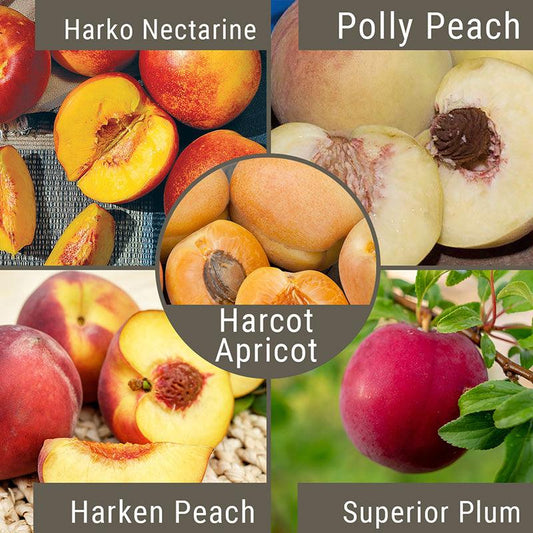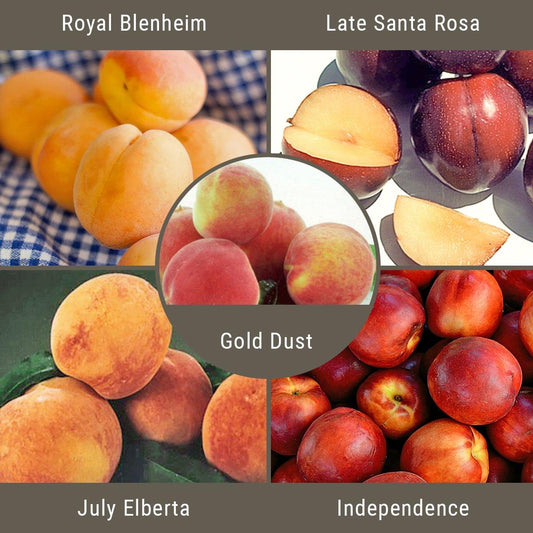If you want to enjoy different kinds of fruit from a single tree, our collection of multi grafted fruit trees is the perfect choice. These trees are created by grafting several fruit varieties—such as apples, pears, cherries, pluots, or stone fruit like peaches plums—onto semi-dwarf rootstocks. The result is a compact, manageable tree that produces a wide range of fruit.
Each multi grafted fruit tree is designed for gardeners who want variety, efficiency, and productivity in their backyard or home orchards. They feature strong graft unions that support long-term growth, balance between varieties, and reliable harvests. By planting just one of these grafted fruit trees, you can enjoy the taste of multiple fruits for years to come.
Why Choose Multi Grafted Fruit Trees?
Multi grafted trees offer unique benefits that make them stand out among other fruit trees:
-
Multiple fruits on one tree – Grow apples, pears, cherries, pluots, or a mix of nectarines, apricots, peaches, plums, and more.
-
Space-saving design – A single tree can replace several, making it perfect for patios, yards, or small gardens.
-
Extended harvest window – Each variety ripens at a different time, so you get a longer fruiting season.
-
Better pollination – Compatible varieties on one tree help with fruit set.
-
High quality craftsmanship – Each tree is carefully grafted to ensure strength, flavor, and resilience.
This makes multi grafted fruit trees a smart investment for both new gardeners and experienced growers.
If you’re curious about planting strategies, see our guide on high-density planting and pruning for home orchards.
Popular Types of Grafted Fruit Trees
Our selection of multi grafted fruit trees includes a wide range of combinations to fit every gardener’s taste.
-
Apple Trees – From “Constant Harvest” to low-chill multi-grafted varieties, these apple trees give you multiple types of apples on one tree. They’re excellent for snacking, baking, and storing.
-
Pear Trees – Choose from disease-resistant pears or Asian pears, each offering reliable growth and delicious harvests.
-
Cherries and Pluots – Our Sweet Cherry and “Constant Harvest” Pluot trees are among the most popular multi grafted fruit options.
-
Stone Fruit Blends – The “Fruit Salad” trees are true favorites. They combine peaches, plums, nectarines, and apricots on one tree for the ultimate variety.
Looking specifically for apple and pear? We carry separate multi-grafted apple trees and pear trees. Plant them together in your yard, and you can enjoy both fruits side by side.
All of our grafted trees are built for the long term, with strong graft unions that support balanced growth and productivity.
Trees That Produce More in Less Space
Multi grafted trees are often called trees that produce more because they pack variety into one compact form. Instead of needing five separate fruit trees, you can have a multi grafted tree that does the work of many. This makes them a great choice for:
- Small gardens and patios where space is limited
- Home orchards that want maximum yield without crowding
- Gardeners seeking variety without the challenge of managing multiple trees
With careful training and pruning, these trees remain easy to manage while still delivering abundant harvests.
How to Care for Your Multi Grafted Fruit Tree
To get the best results, care for your tree with consistent attention.
-
Planting – See our guide on how to plant a bare root fruit tree for step-by-step instructions.
-
Pruning – Each grafted branch needs balance. Prune in late winter to shape the tree and keep sunlight reaching all varieties.
-
Fertilizing – Apply organic fertilizer in spring to boost growth and fruit set. Learn more in when and how to fertilize fruit trees.
-
Watering – Provide steady moisture, especially in the first year and during hot weather.
-
Disease and pest management – Keep good airflow between branches and monitor for pests or signs of disease.
By giving your tree the right care, it will stay strong and productive for many years. For more growing advice, visit our Fruit Tree Resource Center.
Why Buy Multi Grafted Fruit Trees From Us?
You’re choosing multi grafted fruit trees that are:
- Grown outdoors for strength and adaptability
- Built with durable graft unions for long-term health
- Selected for high quality taste and dependable yields
- Designed to thrive in home gardens and larger orchards
Each multi grafted fruit tree we sell is carefully crafted to give you variety, resilience, and flavor—all in one compact tree. Whether you want to grow apple trees, pears, cherries, pluots, or a blend of stone fruit, our collection has something for every gardener.
Invest in Variety and Flavor
Our collection of grafted fruit trees is perfect for anyone who wants more from their garden. With just a single tree, you can enjoy the taste of apples, pears, cherries, or mixes of stone fruit like peaches and plums. These multi grafted fruit trees are efficient, reliable, and built to last, making them an investment in flavor and productivity for the future.


















